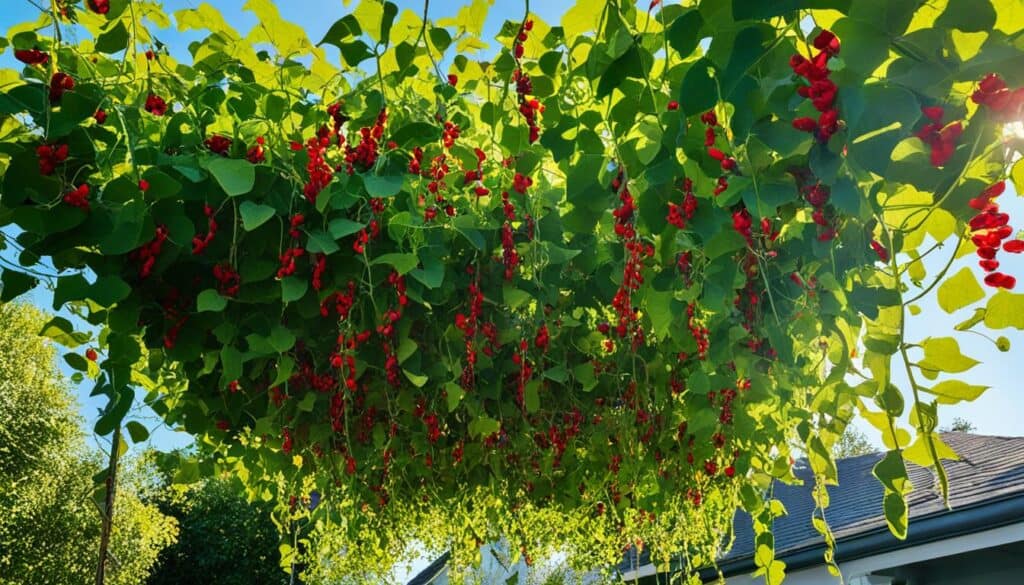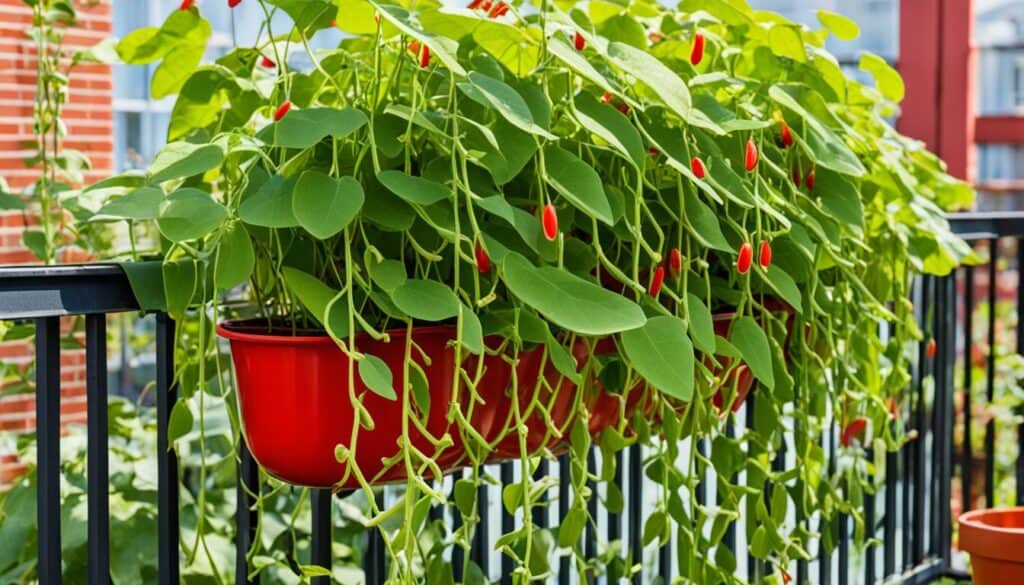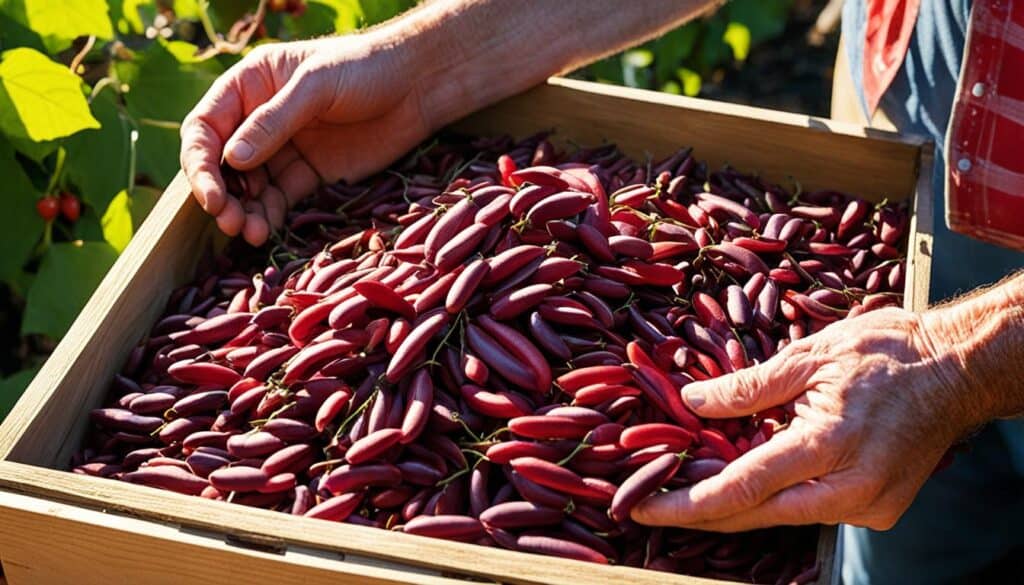Scarlet runner beans, also known as Phaseolus coccineus, are a hidden gem in the gardening world. These vibrant and eye-catching plants are often grown for their stunning flowers, but they also offer an abundance of delicious, nutritious, and organic legumes. In this article, I will share with you tips and tricks on how to grow scarlet runner beans successfully, ensuring a bountiful harvest and a feast for the senses.
Key Takeaways:
- Scarlet runner beans are versatile plants that can be grown for both food and ornamental purposes.
- They require full sun and consistent moisture to thrive.
- Caution should be exercised as the beans of scarlet runner beans are toxic when eaten raw.
- Plant scarlet runner beans in the spring after the threat of frost has passed, providing supports for the climbing vines.
- Regular watering, slightly acidic to neutral pH soil, and adding compost can help promote vigorous growth.
Planting Scarlet Runner Beans
When it comes to planting scarlet runner beans, timing and proper technique are crucial for a successful and abundant harvest. In this section, I will guide you through the best practices for planting scarlet runner beans, including when to plant, how to plant, and the necessary supports for optimal growth.
When to Plant Scarlet Runner Beans
The ideal time to plant scarlet runner beans is in the spring, after the threat of frost has passed and the soil has warmed up. These beans thrive in warm weather and need plenty of sunlight to grow vigorously.
How to Plant Scarlet Runner Beans
To ensure a healthy start for your scarlet runner beans, follow these simple steps:
- Choose a planting site that offers good drainage and receives full sun.
- Prepare the soil by loosening it with a garden fork or tiller and removing any weeds or debris.
- Plant the scarlet runner bean seeds about 2 inches deep and space them 6 inches apart.
- Water the seeds gently but thoroughly after planting to help promote germination.
- Provide supports for the beans at the time of planting. Bamboo canes, trellises, or other sturdy structures make excellent supports for these vining plants.
By planting your scarlet runner beans correctly, you’ll give them the best chance to thrive and produce a bountiful harvest.
“A well-prepared planting site and proper seed spacing are crucial for successful scarlet runner bean growth.”
Now that you know how and when to plant scarlet runner beans, let’s move on to the next section, where we will explore essential care tips to ensure your plants stay healthy throughout the growing season.
Care for Scarlet Runner Beans
When it comes to caring for your scarlet runner beans, there are a few key factors to keep in mind. These plants thrive in full sun, so be sure to choose a location in your garden that receives at least 6-8 hours of direct sunlight each day. Additionally, scarlet runner beans require consistent moisture to grow their best, so regular watering is essential.
Watering scarlet runner beans is a balancing act. You want to keep the soil lightly moist, but be careful not to overwater and make it waterlogged. Aim to water deeply once or twice a week, depending on the weather conditions. If you’re not sure when to water, check the soil with your finger. If it feels dry about an inch below the surface, it’s time to water.
| Soil pH for Scarlet Runner Beans | Recommended pH Range |
|---|---|
| Acidic | 5.5 – 6.5 |
| Neutral | 6.0 – 7.0 |
Scarlet runner beans prefer a slightly acidic to neutral pH soil for optimal growth. A pH range of 5.5 to 7.0 is ideal. You can test your soil’s pH using a home testing kit or by sending a sample to a local agricultural extension service. If the pH of your soil is too low or too high, you can adjust it by adding organic matter, such as compost or well-rotted manure. These amendments will not only help to balance the pH but also provide essential nutrients to the plants.
In addition to watering and maintaining the correct soil pH, scarlet runner beans benefit from regular feeding. Adding compost to the soil in the fall and mid-growth season can help provide a nutrient boost and promote vigorous production. Simply spread a layer of compost around the base of the plants, being careful not to cover the beans themselves.
Remember, scarlet runner beans are not cold hardy and will die when the first frost arrives in the fall. So be sure to plan your planting and harvesting timeline accordingly.
As I care for my scarlet runner beans, I always marvel at their beautiful red flowers and the bountiful harvest they provide. With proper watering, soil pH management, and a little extra love, these beans will thrive and reward you with a plentiful harvest.
Support and Pruning for Scarlet Runner Beans
Scarlet runner beans, with their vigorous climbing habit, require proper support to thrive. Providing sturdy supports such as poles, trellises, or strings is essential for their growth and development. These structures not only prevent the plants from sprawling on the ground but also create an aesthetic vertical element in the garden.
“A well-supported scarlet runner bean plant is not only visually appealing but also allows for better air circulation and sunlight exposure, leading to healthier plants and increased yields.”
When it comes to pruning scarlet runner beans, it’s important to note that their pruning requirements are minimal. However, pinching the tops of the plants once they have reached the top of their supports can be beneficial. This simple technique redirects the plant’s energy towards producing more flowers and pods, resulting in a bountiful harvest.
To illustrate the proper support and pruning techniques for scarlet runner beans, refer to the table below:
| Support Method | Description | Benefits |
|---|---|---|
| Poles | Insert tall poles into the ground at regular intervals around the planting area. Secure the plants to the poles using plant ties or soft twine. | – Provides vertical support and prevents plants from sprawling on the ground – Allows for better air circulation and sunlight exposure – Ease of harvesting due to vertical growth |
| Trellises | Erect a trellis structure with horizontal and vertical wires or wooden slats. Encourage the plants to climb the trellis by gently guiding their tendrils. | – Offers a decorative element in the garden – Promotes vertical growth and efficient use of space – Facilitates good air circulation and sunlight penetration |
| Strings | Tie a series of strings vertically between two sturdy supports, such as stakes or posts. Allow the plants to entwine themselves around the strings. | – Provides a simple and inexpensive support option – Allows for easy adjustment of string height as plants grow – Enhances the visual appeal of the garden |
Note: Make sure to secure the supports firmly to withstand the weight of the plants and any windy conditions. Regularly check the plants’ growth and readjust the ties or strings as needed to prevent damage.
Pruning Scarlet Runner Beans:
- Pinch the tops of the plants once they’ve reached the top of their supports.
- Focus on removing the growing tips, allowing the plants to redirect their energy towards pod production.
- Pruning can be done with clean gardening shears or simply by pinching off the top growth using your fingers.
By providing reliable support and implementing proper pruning techniques, you can ensure that your scarlet runner beans grow vertically, stay healthy, and produce abundant flowers and pods for your culinary delight.
Growing Scarlet Runner Beans in Containers
Growing scarlet runner beans in containers offers a convenient solution for gardeners with limited space or those who prefer the flexibility of container gardening. With proper care and the right container size, you can enjoy a bountiful harvest of these vibrant and nutritious legumes.
When it comes to choosing a container for scarlet runner beans, size matters. These plants require a fairly large container to accommodate their vigorous growth. A container that is at least 30 inches wide and 18 inches deep is recommended to provide enough space for the roots to develop and support the tall vines as they reach for the sky.
In addition to size, the container should have drainage holes to prevent waterlogged soil, which can lead to root rot. It is essential to use a loose and well-draining organic soil mix to promote healthy root growth and prevent water stagnation.
If you are starting with seedlings in smaller pots, you may need to repot them into larger containers as they grow. However, to minimize root disturbance, you also have the option of directly sowing the seeds into the large container from the beginning.
Note: Remember to add proper care to ensure the success of your container-grown scarlet runner beans.
Benefits of Growing Scarlet Runner Beans in Containers:
There are several benefits to growing scarlet runner beans in containers:
- Space-saving: Containers allow you to grow these beans in small spaces such as patios, balconies, or even windowsills.
- Easy mobility: Containers can be moved to optimize sunlight exposure or protect the plants from adverse weather conditions.
- Protection from pests: Container gardening can help reduce the risk of pests and diseases, as the beans are elevated from the ground.
Indulge in the joy of container gardening and enjoy a vibrant display of scarlet runner beans right at your doorstep!
Pest and Disease Prevention for Scarlet Runner Beans
When it comes to pest and disease problems, scarlet runner beans are generally hardy and resistant. However, there are a few common pests and diseases that can affect these plants and potentially hamper their growth. By taking proactive measures and implementing good gardening practices, you can prevent and control these issues, ensuring a successful harvest of your scarlet runner beans.
Common Pests of Scarlet Runner Beans
Scarlet runner beans may attract various pests that can cause damage to the plants. Some of the most common pests that gardeners encounter when growing scarlet runner beans include:
- Mexican bean beetles
- Japanese beetles
- Aphids
- Slugs
These pests can feed on the bean leaves, stems, and even the pods, leading to stunted growth and reduced yield. Regular inspection of your plants and prompt action are crucial to preventing an infestation and minimizing the damage caused by these pests.
Prevention and Control
To prevent and control pest problems in your scarlet runner bean plants, consider implementing the following practices:
- Good garden hygiene: Remove any plant debris or fallen leaves from around your bean plants regularly. This helps eliminate hiding places for pests and reduces the risk of infection.
- Companion planting: Planting companion plants such as marigolds, basil, or nasturtiums around your scarlet runner beans can help deter pests.
- Natural pest control: Utilize natural pest control methods such as handpicking and removing pests manually, using organic insecticidal soaps or neem oil, or introducing beneficial insects like ladybugs or lacewings to feed on pests.
Common Diseases of Scarlet Runner Beans
While scarlet runner beans are generally disease-resistant, there are a few diseases that can still pose a threat to these plants:
- Mosaic virus
- Blight
- Anthracnose
- Powdery mildew
These diseases can spread through infected plant material or by insect vectors. Early detection and proper management are crucial to prevent the diseases from spreading and causing significant damage to your scarlet runner beans.
Prevention and Control
To prevent and control diseases in your scarlet runner bean plants, consider implementing the following practices:
- Rotating crops: Avoid planting scarlet runner beans in the same location every year. Rotate them with other crops to reduce the risk of disease buildup in the soil.
- Planting disease-resistant varieties: Choose disease-resistant varieties when available to minimize the risk of infection.
- Proper spacing: Plant scarlet runner beans with adequate spacing to promote good air circulation, which can help prevent the spread of diseases.
- Fungicidal treatments: In cases where diseases are severe and pose a significant risk to your plants, consider using organic fungicidal treatments as a last resort.
By following these preventive measures and promptly addressing any pest or disease issues that may arise, you can ensure that your scarlet runner beans thrive and produce a bountiful harvest.
| Pest | Damage | Prevention and Control |
|---|---|---|
| Mexican bean beetles | Feeding on leaves, pods, and stems | Handpick the beetles off the plants |
| Japanese beetles | Feeding on leaves, causing skeletonization | Use pheromone traps to attract and capture them |
| Aphids | Sucking sap from leaves, causing curling and distortion | Spray plants with a strong stream of water or use insecticidal soap |
| Slugs | Feeding on leaves, creating irregular holes | Implement slug barriers or traps to catch and remove them |
Harvesting and Storing Scarlet Runner Beans
When it comes to harvesting scarlet runner beans, timing is key. The exact time for harvesting depends on when the beans were sown, but generally, they become ready for harvest around midsummer. To enjoy these delicious beans, you have two options: picking them when they are young and tender for immediate cooking or allowing them to fully mature for shelling or drying.
When harvesting scarlet runner beans, it is important to do it regularly to encourage continuous production. Regular harvesting prevents the pods from becoming overripe and tough, ensuring optimal flavor and texture.
Ready to harvest beans should be firm to the touch and have a vibrant color. Their size will depend on the specific variety you are growing. To harvest, simply grasp the pod firmly and gently pull it away from the plant. If the pods don’t come off easily, they may not be fully matured yet, so it’s best to leave them be for a little longer.
Now that you have harvested your scarlet runner beans, it’s time to think about storing them. If you plan to use the beans within a week, you can store them in the refrigerator in a breathable container or bag. This will help maintain their freshness.
Alternatively, if you would like to preserve them for a longer period, you can choose to dry the beans. To do this, let the pods mature on the plant until they dry out and turn brown. Once completely dry, remove the beans from the pods and store them in an airtight container in a cool, dry place.
When properly stored, dried scarlet runner beans can last for several months, making them a great option for long-term storage and future use in soups, stews, or other delicious recipes.
Tips for Harvesting and Storing Scarlet Runner Beans:
- Harvest pods when they are firm, vibrant, and the appropriate size.
- Regular harvesting encourages continuous bean production.
- Store fresh beans in the refrigerator for up to a week.
- To dry scarlet runner beans, let the pods fully mature and dry on the plant.
- Store dried beans in an airtight container in a cool, dry place.
Scarlet Runner Beans: A Nutritious and Versatile Legume
Scarlet runner beans not only provide a burst of flavor in your meals but also deliver a range of health benefits. These vibrant legumes are packed with essential nutrients that can support your overall well-being. From protein and fiber to vitamins and minerals, these beans are a powerhouse of nutrition.
When it comes to cooking, scarlet runner beans open up a world of possibilities. Their hearty texture and rich flavor make them a perfect addition to soups, stews, and salads. They can be sautéed, steamed, or baked, adding a nutritious touch to your favorite recipes. Whether you are a vegetarian, vegan, or simply looking to incorporate more plant-based meals into your diet, scarlet runner beans are a versatile ingredient that can fit any culinary preference.
Looking to try out some exciting recipes with scarlet runner beans? Here are a few delicious options:
- Scarlet Runner Bean Salad with Citrus Dressing
- Spicy Scarlet Runner Bean Chili
- Scarlet Runner Bean and Roasted Vegetable Medley
These recipes showcase the adaptability of scarlet runner beans in various cuisines, allowing you to savor their distinct flavor while reaping their health benefits.
| Health Benefits of Scarlet Runner Beans |
|---|
| Packed with protein, essential for muscle repair and growth |
| High in fiber, aiding in digestion and promoting satiety |
| Rich in vitamins A and C, boosting the immune system |
| Source of iron, supporting healthy blood circulation |
| Contain potassium and magnesium, contributing to heart health |
By incorporating scarlet runner beans into your meals, you can enjoy their health benefits while indulging in delicious and nutritious dishes. So why not give these fantastic legumes a try and elevate your culinary creations?
Varieties of Scarlet Runner Beans
When it comes to scarlet runner beans, gardeners have the opportunity to choose from a variety of options. Each type of scarlet runner bean offers its own unique appearance and characteristics, allowing you to find the perfect fit for your preferences and growing conditions.
Here are some popular varieties of scarlet runner beans:
- ‘Hestia’: This variety of scarlet runner bean features vibrant red flowers and is known for its compact size, making it ideal for small gardens or containers.
- ‘Moonlight’: With its striking yellow flowers, ‘Moonlight’ adds a touch of brightness to any garden. This variety is also known for its high tolerance to heat and dry conditions, making it a resilient choice.
- ‘Painted Lady’: Known for its beautiful bi-color flowers in shades of red and white, ‘Painted Lady’ is a classic and popular choice among gardeners. It is also known for its high productivity.
- ‘Prizewinner’: As its name suggests, ‘Prizewinner’ is a top performer in the garden. It produces lovely red flowers and boasts excellent disease resistance, ensuring a successful harvest.
- ‘Sunset’: This variety showcases stunning orange flowers that will add a warm and inviting touch to your garden. ‘Sunset’ is also known for its vigorous growth and abundant yield.
Whether you prefer the classic look of red flowers, the boldness of yellow or orange, or the charming bi-color display, there is a scarlet runner bean variety that suits your taste. Consider the unique characteristics of each type and choose the one that best complements your garden design and growing conditions.
Comparison of Scarlet Runner Bean Varieties
| Variety | Flower Color | Tolerance | Productivity | Disease Resistance |
|---|---|---|---|---|
| ‘Hestia’ | Red | Compact size | High | Good |
| ‘Moonlight’ | Yellow | Heat and dry conditions | High | Moderate |
| ‘Painted Lady’ | Red and white | High productivity | High | Good |
| ‘Prizewinner’ | Red | Excellent disease resistance | High | Excellent |
| ‘Sunset’ | Orange | Vigorous growth | High | Moderate |
Discovering the different types of scarlet runner beans allows you to personalize your gardening experience and enjoy the unique features of each variety. Whether you prefer compact size, heat tolerance, high productivity, or disease resistance, there is a scarlet runner bean variety out there that will meet your needs.
Conclusion
Scarlet runner beans are a fantastic addition to any garden, offering both beauty and abundant harvests. These versatile plants can be grown for both food and ornamental purposes, adding a vibrant touch to your outdoor space. By following the proper planting, care, and harvesting techniques, you can enjoy the benefits of growing your own organic scarlet runner beans.
When it comes to gardening, scarlet runner beans are a great choice. Not only do they require full sun and consistent moisture to thrive, but they also offer a range of health benefits. Packed with protein, fiber, vitamins, and minerals, these beans are a nutritious addition to your diet.
Furthermore, scarlet runner beans are incredibly versatile in the kitchen. From soups and stews to salads and side dishes, there are countless ways to incorporate these beans into your favorite recipes. Their rich flavor and hearty texture make them a delicious and satisfying ingredient for both vegetarian and meat-based dishes.
Whether you’re a seasoned gardener or just starting out, scarlet runner beans are a must-have for your garden. With their stunning flowers, bountiful harvests, and culinary versatility, these beans will not disappoint. So why wait? Start growing scarlet runner beans and experience the joy of cultivating your own organic food right at home.










Leave a Reply